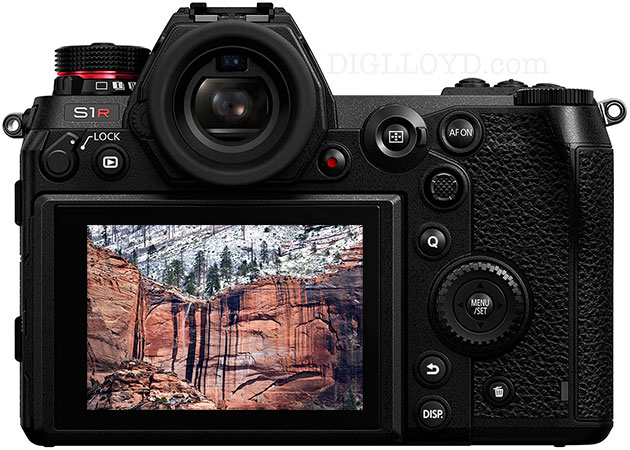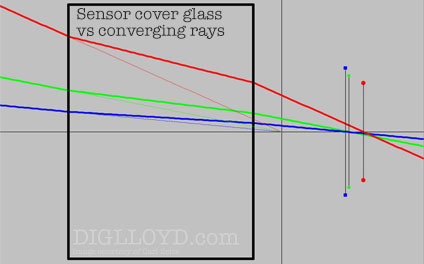Panasonic S1R vs Leica SL2: Sensor Cover Glass Thickness vs Performance for Leica M Lenses, L-Mount Lenses
re: Panasonic S1R and Leica SL2 (L-Mount) — Potentially the Best 35mm Quality?
re: Panasonic S1R vs Other Cameras for Landscape — Transition Camera for Zeiss Otus/Zeiss Milvus 'glass'?
re: Sensor Cover Glass Thicknes for Various Cameras
re: Ray Angle and Digital Sensors
re: Table of ray angles for Zeiss ZM lenses and Ray Angle and Entrance Pupil
re: MTF on Mirrorless Cameras, Sensor Cover Glass
re: sensor cover glass
Ten days ago I wrote about the thickness of the sensor cover glass and/or micro lenses on the Panasonic S1R vs Leica SL2, in regards to lens performance.

One would hope and reason that the L-Mount alliance would standardize on sensor cover glass thickness and characteristics, but is that a safe assumption, what with Leica possibly wanting better M-lens performance? A lens mount standard does not necessarily imply sensor characteristics that are the same. Deviation would be a fraud of sorts by the L-Mount alliance, since it would degrade the concept of interchangeable lenses. But it might well be so.
What I don’t know is whether Leica and Panasonic lens performance is degraded by being used on the other vendor’s camera eg Leica SL lenses on Panasonic, or Panasonic lenses on the Leica SL2. The same mount does not guarantee the same sensor cover glass thickness or micro lens array. Indeed, if the Leica SL2 is somehow optimized for (also) Leica M lenses, could that disturb performance for Panasonic lenses?
The question of interchanging lenses as stated above needs an answer. But it would seem brain-dead that newly-engineered lenses designed for L-Mount mirrorless would have performance issues across brands (Leica, Panasonic, Sigma)—a shit-the-bed alliance if so. Still, it might be the case.
See also:
LensRentals.com: The Glass in the Path: Sensor Stacks and Adapted Lenses
LensRentals.com: Sensor Stack Thickness: When Does It Matter?

M-mount lenses
Peter Karbe of Leica acknowledges that M lenses are best on M cameras, next best on Leica SL2/SL (but he is cagey about it), and lousy on the "S" brand (Sony).
But in truth Leica M lenses are poor performers on everything by modern standards, even on the 40-megapixel Leica M10-R and Leica M10M (the best case!), as I showed with a variety of them in December 2020. Peter Karbe in effect states in that video that they were designed for at most a 24MP sensor. So the truth is that Leica M lenses should be used for their rendering style, not because they have anything useful to offer on the sharpness front. If you choose to shoot them on a 40/47MP sensor, think of it as oversampling that will reduce digital artifacts relative to an 18/24MP sensor, e.g., moiré and staircasing, and more subtle color/tone gradation.
Another issue is that color shading (vignetting by color) requires camera support to neutralize. Sharpness aside, support for Leica M lenses may mean that the Panasonic S1R is a 2nd-rate choice for M lenses.
A few years ago I proved that even with the very best Leica M performer, the Zeiss ZM 35mm f/1.4 Distagon, optimal performance requires f/5.6 to f/8 on the Panasonic S1R. Would it be better on the Leica SL2? Were I to bet, I’d guess it’s minimally different, maybe half a stop.
BTW, the Zeiss ZM 35mm f/1.4 Distagon is designed expecting a 0.8mm thick sensor cover glass stack.
Sensor cover glass and ray angle
Recall that the total thickness of the sensor cover glass* is critically important for lens performance for lenses never designed for digital, in particular Leica M lenses, which do not and have never performed as claimed by MTF charts (on digital cameras), even on Leica M bodies—because any glass in the optical path degrades performance, even the 0.9mm-thick glass of the Leica M240. And that’s ignoring the serious problems with color shading.
Optically, it is ray angle interacting with sensor cover glass that causes increasing degradation of image quality off-axis to a degree proportional to the angle of incidence. The center only sees a displacement of focus (1/3 of the thickness), but off-axis, increasingly severe astigmatism quickly degrades image quality. Which is why anything short of f/5.6 sucks for performance of Leica M lenses on digital bodies. Even Leica M cameras (most friendly to M lenses) can barely get there by f/4, even with recent lenses like the Leica 50mm f/2 APO-Summicron-M ASPH. This is obvious, as I have shown in dozens of aperture series.
There is also the issue of micro lenses, said to improve performance of Leica M lenses. The Leica SL2 allegedly has micro lenses, and the Panasonic S1R apparently does not. But AFAIK, the micro lenses are a secondary and relatively minor issue after the sensor cover glass vs ray angle degradation behavior.
* Sensor cover glass in reality is a stack of glass layers with nearly all cameras, some bonded on, some separate layers. The total optical thickness is what matters. A simplification is to refer to this as the “sensor cover glass” thickness—the totality.
Sensor cover glass stack thickness of Panasonic S1R, Leica SL2
I still cannot find information on the sensor cover glass stack thickness of the Leica SL2. But the Panasonic S1R has a relatively thin sensor cover glass (but still too thick to perform well with M-mount lenes).
From Kolarivision PANASONIC S1R DISASSEMBLY AND TEARDOWN:
These layers of sensor cover glass (Panasonic S1R) have a combined thickness of roughly 1.45 millimeters. This is thinner than the EOS R, but a decent sight thicker than the Z7’s 1.1mm [diglloyd: actual total thickness is 2.3mm], the thinnest we’ve come across yet. This makes the S1R a poor candidate for legacy Leica lens performance despite the partnership with Leica, meaning this camera is another excellent candidate for our Ultra-Thin filter modification service.
The Panasonic S1R at 1.45mm thick (is this the total thickness?!) is far thinner than Sony mirrorless at ~3mm thick. Hence the horrible performance of M-mount lenses on Sony cameras and the slightly better performance on the Nikon Z7. Judging by my testing, I’m skeptical that the total glass thickness on the Panasonic S1R is only 1.45mm. Even if accurate, that’s a lot thicker than the optimal of 0.8mm thickness.
Ilija Melentijevic of Kolarivision writes:
We haven’t tested the SL2 yet so I can’t comment.
The numbers we report on the sensor glass is only the removable UVIR cut layers, and excludes the permanent clear cover window in the sensor itself. This layer is typically 0.8-1mm but is hard to measure non destructively.
That would make the Panasonic S1R around 2.4mm and the Nikon Z7 around 2.1mm.
Leica will typically install their UVIR cut layer in place if the typical permanent clear window, allowing them to achieve the thinnest total stack.
DIGLLOYD: so it’s not possible for the Panasonic S1R to deliver good M-mount lens performance short of f/5.6 or f/8, given its 2.4mm thickness. But what about the Leica SL2?
If Leica SL2 sensor cover glass stack thickness were to match the Leica M cameras (0.8mm), and there were also micro lenses on the sensor, then M lenses would perform just as well. However, my guess is that there is additional thickness (0.8mm more, at least?), and that would explain why Peter Karbe is coy about the matter.
If Leica SL2 sensor cover glass stack thickness is much thinner than the S1R, then it implies moderately impaired lens performance for Leica SL lenses on the Panasonic S1R and moderately impaired lens performance for Panasonic lenses on the Leica SL2. What does that mean for Sigma L-mount lenses?!
Physical (only) mount compatibility constitutes an “interchangeable” lens mount system? At best this is not entirely honest.

























